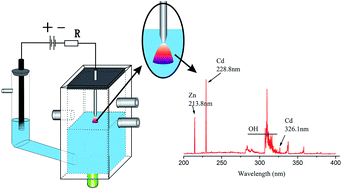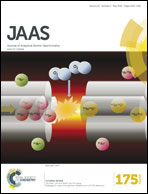Highly sensitive elemental analysis of Cd and Zn by solution anode glow discharge atomic emission spectrometry
Abstract
In this study, a highly sensitive liquid electrode discharge atomic emission source was developed for the determination of Cd and Zn in aqueous solutions. In contrast to the common electrolyte cathode atmospheric glow discharge (ELCAD) approach, the source utilizes an electrolyte solution containing the analyte as the anode. With this design, the sensitivity of Cd and Zn is significantly enhanced and LODs could be improved by at least one order of magnitude. In this approach, the volatile species of Cd and Zn can be readily generated at the plasma–liquid interface probably resulting from electron transfer reactions at the plasma–liquid interface, which greatly increase the sample introduction efficiency, and thus provide high sensitivity. In addition, the device operates comfortably at low power (<7 W). The effects of operating parameters such as electrolyte pH, discharge current, Ar gas flow rate and sample introduction rate were investigated. The LODs were calculated to be 0.05 μg L−1 for Cd and 0.14 μg L−1 for Zn under optimized conditions. The repeatability values, expressed as the relative standard deviation of the emission signals, for four replicate measurements of 10 μg L−1 of Cd and Zn were 3.8% and 4.0% respectively. The proposed excitation source provides a low-cost, low power consumption and sensitive method for the determination of Cd and Zn at ultra-trace levels.


 Please wait while we load your content...
Please wait while we load your content...